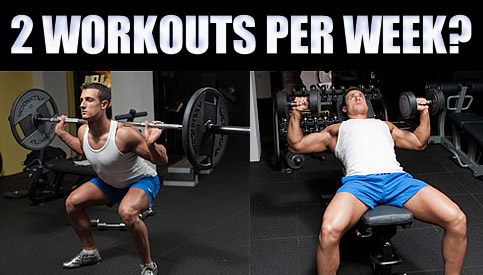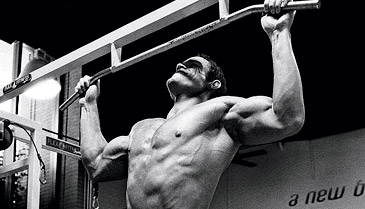CAN YOU BUILD MUSCLE WITH ONLY 2 WORKOUTS PER WEEK?

Some like the bro split. Others like push-pull-legs. But, what about 2 workouts per week to build muscle?
When it comes to training for increased muscle size and strength, 3-4 weight training workouts per week is the usual standard for most average lifters.
This is the “sweet spot” that I’d recommend to the majority of trainees, as it’s a high enough frequency to optimize the overall workload for each muscle group without going unnecessarily overboard.
However, a reader recently sent in the following question…
“Hey Sean – I’m currently working 50 hour weeks in combination with juggling family responsibilities and performing jiu jitsu 2-3 times a week. Things are quite busy and stressful. Can I still make solid gains by weight training with just 2 workouts a week?”
Although 3-4 weekly workouts is usually best in order to fully maximize progress (5 can work in some cases as well, but only in more advanced lifters), can twice-per-week training still produce decent results?
Let’s talk about it…
Can You Gain Muscle Effectively With Only 2 Workouts Per Week?

The short and simple answer?
Yes, you definitely can gain muscle size and strength consistently by working out twice per week, as long as your training sessions are properly structured and executed.
Is working out twice a week going to be optimal for building the very best physique in the shortest time?
Probably not, but keep in mind that there’s a big difference between “optimal” and “effective.”
Just because a particular training style isn’t the absolute best way to go about it does not mean that you can’t still make significant progress that way.
Any workout plan that directly trains each muscle group at least once per week with sufficient volume and intensity and allows for progressive overload will produce consistent gains as long as you stick with it.
In fact, in my earlier bodybuilding days when I followed a low volume/high intensity approach to lifting (otherwise known as “HIT”, or “high intensity training”), I went through several phases where I was only in the gym literally once every 3-4 days.
Despite averaging only two weight training workouts per week, I was still able to make continual gains from session to session.
Could I have made faster progress with a higher frequency approach?
Most likely, but the point here is that lower frequency training still works.
Hitting each muscle group only once per week was actually a standard bodybuilding guideline in previous years, and this can certainly be accomplished with sufficient volume and intensity even on a two-day-per-week workout plan.
However, this shouldn’t be used as an excuse to train less often if you truly do have the time and energy available for 3 weekly workouts.
Keep in mind that you don’t need to spend hours and hours in the gym to get an effective workout – all it usually takes is about 60-75 minutes from start to finish including your warmup (which, you should be doing to help reduce your risk for injury).
So, the first thing I’d recommend before going further is to really examine your weekly schedule to see where you might be able to fit in that one extra training session.
When you really break it all down piece by piece, you’ll usually find that there are plenty of opportunities available.
If you truly don’t have the time or energy for more than two workouts per week though (or if bodybuilding is more of a casual hobby for you than a primary focus), here’s how I’d recommend going about it…
What’s The Best 2-Day-A-Week Workout Plan?

If you’re only going to be dedicating two days a week to the gym, you’ll want to keep things basic and to-the-point.
A full body workout is a great way to accomplish this.
You don’t need to include a huge variety of different exercises or worry about targeting each muscle from every possible angle.
Instead, stick to the basics and center your workouts around the big compound exercises that train your largest muscle groups, and focus on making consistent strength gains on them over time.
These are the core movements patterns you’ll want to hone in on:
- Squat (barbell back squat or any other basic squatting variation)
- Hip hinge (deadlift, Romanian deadlift, glute-ham raise etc.)
- Horizontal press (bench press, dumbbell press, machine press etc.)
- Horizontal pull (barbell row, dumbbell row, machine row etc.)
- Vertical press (military press, seated overhead dumbbell press etc.)
- Vertical pull (pull up, chin up, pulldown etc.)
Rather than trying to include every single one of these exercises in each workout, a good approach is to split them up and perform half on one day and half on the other.
For example, you could do a squat, horizontal press, and horizontal pull for workout A, and then a hip hinge, vertical press, and vertical pull for workout B.
After those main compound lifts are complete, you can add in 2-3 accessory movements to directly train your smaller muscle groups, such as the biceps, triceps, side/rear delts, calves, and abs.
Two other options for laying out an effective twice-per-week workout would be an upper body/lower body split (pretty self explanatory) or a push/pull split (squat/horizontal press/vertical press on one day, and then a hip hinge/horizontal pull/vertical pull on the other).
Any of these approaches will ultimately be effective, and you can give each of them a try and see which one you prefer.
Additional Points To Consider

Keep in mind that since you’ll be training with less frequency and volume in comparison to 3-4 sessions a week, your “margin for error” will be smaller as well.
In other words, you need to ensure that you’re making the very most of each workout by training with a sufficient level of intensity and executing each set with proper technique.
In order to maximize the stimulation of each muscle, I wouldn’t suggest training any less than 1 rep short of concentric muscular failure.
If you’re a bit more advanced and really want to condense your workouts down even further, you can reduce the volume (2 sets per exercise for example) and go with a HIT style routine by taking every set all the way to muscular failure.
Just like with any proper muscle building training plan, make sure to write down your workouts in detail by keeping track of which exercises you performed along with the amount of weight lifted and reps executed on each set.
From there, strive for continual improvement each week by either performing an extra rep or two with the same weight, or increasing the load by 5-10 pounds.
As long as you’re steadily adding more weight to the bar over time and your nutrition is on point, you’ll know that your twice-per-week training plan is working.
Also, on the topic of nutrition, keep in mind that if you’re not training as often throughout the week, you’ll want to bring your overall calorie intake down slightly as well.
Since you’ll be burning fewer total calories in comparison to training 3-4 days a week or more (assuming you aren’t highly active outside of weight training), you won’t require as large of a calorie surplus in order to maximize your gains.
Training only twice a week and combining that with an excessively high calorie intake will increase the chances of unwanted fat gain.
2 Workouts Per Week: The Bottom Line

While the research does indicate that slightly higher frequencies are ideal for maximizing hypertrophy in most average trainees, that doesn’t mean that two workouts per week won’t still be effective.
Maybe you’re leading a very busy lifestyle and struggle to find the time and energy to train more often… maybe you’re dedicated to other active hobbies such as sports or martial arts… or maybe bodybuilding just isn’t your main focus at the moment and you have other higher priorities to take care of.
If that’s the case, condensing your workouts down (at least temporarily) is probably the better decision since it will increase the chances that you’ll actually stick to your training plan longer term.
After all, a slightly sub-optimal workout routine carried out consistently is far and away better than a workout routine that is optimal but unsustainable.
Plenty of people have built great physiques this way, and you can too as long as you lay out your workouts properly, train hard, and eat right.
If you found this article helpful, make sure to sign up for your FREE custom fitness plan below...




